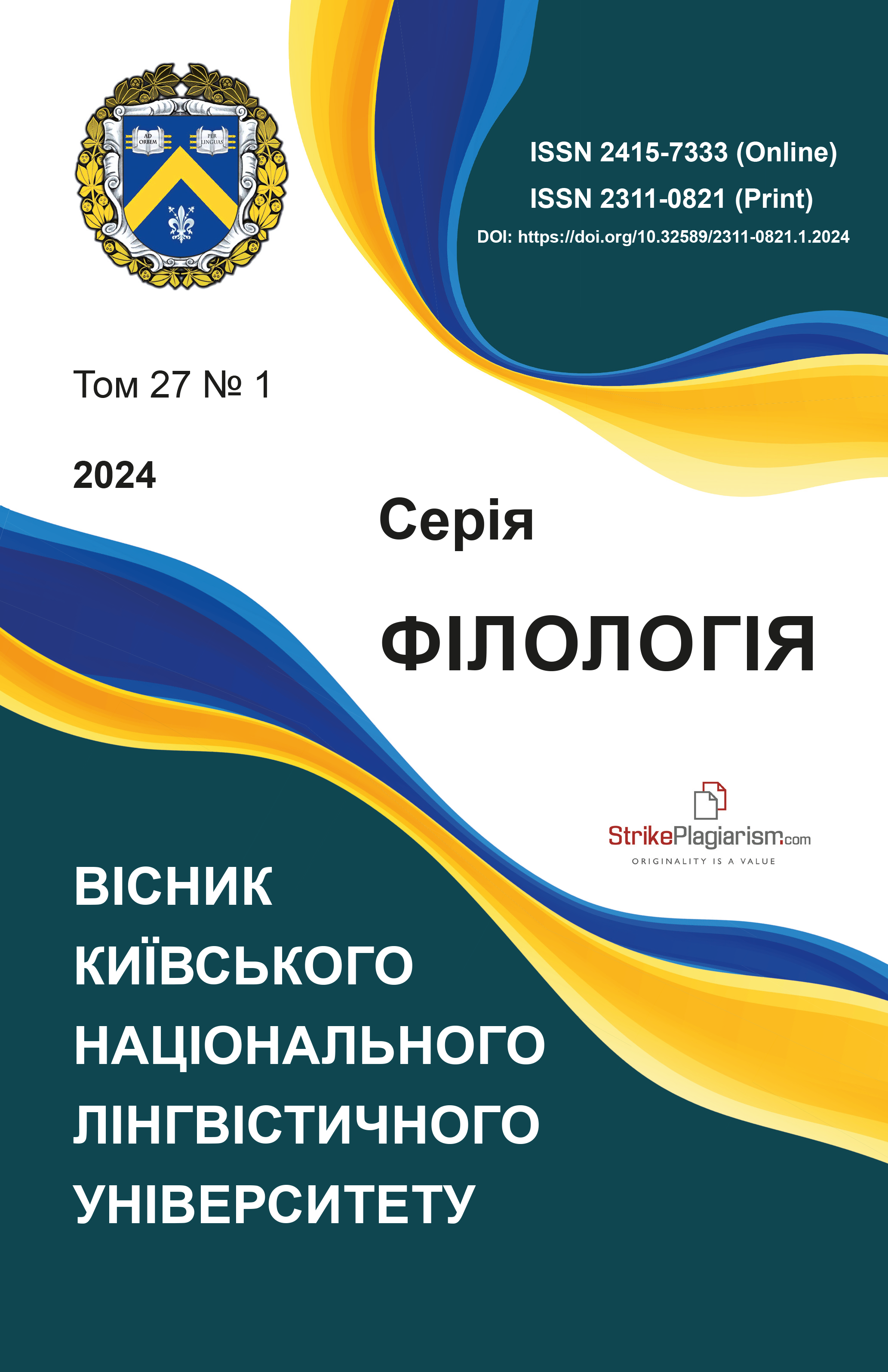Образ Китаю у творах Акутаґави Рюноске
DOI:
https://doi.org/10.32589/2311-0821.1.2024.309603Ключові слова:
імагологія, етнообраз, інтертекстуальність, алюзії, цитатиАнотація
Одним із перспективних напрямів сучасної компаративістики є імагологія, що досліджує літературні етнообрази: як образ своєї (автообраз), так і образи інших етнокультур у національній літературі (гетерообрази). Метою нашої статті є простежити особливості складного й багатоаспектного ставлення Акутаґави Рюноске до Китаю, втілене в його творах, тобто визначити основні риси етнообразу Китаю у творах письменника. У ній розглянуто погляди китайських науковців, які досліджують творчість Акутаґави Рюноске, крізь призму відображення в них образу Китаю. Окреслено китайський складник в інтертекстуальності творів письменника, форми адаптації китайських сюжетів; висвітлено роздуми письменника про історичний вплив культури Китаю на Японію, авторське розуміння тогочасних японсько-китайських взаємин, образ тогочасного Китаю і китайців, який склався в результаті відвідин цієї країни письменником у 1921 році. Зроблено висновок, що китайський складник у вигляді цитат, алюзій, згадок про міфічних чи історичних постатей давнього Китаю, звернень до літературних творів тощо як інтертекстуальна частина творів Акутаґави Рюноске є доволі значною. Як письменник, що часто переосмислював давні сюжети, Акутаґава не обійшов увагою і давні китайські новели. Щодо розуміння тогочасних японсько-китайських взаємин, письменник гостро засуджував війну, показуючи горе і смерть, які вона несе простим людям обох країн. Особисті враження письменника від поїздки до Китаю мали великою мірою негативне забарвлення. Дослідження образу Іншого, а саме образу Китаю та китайців, у творах японської літератури вважаємо актуальними і перспективними, зокрема це стосується глибшого вивчення питання китайського складника в інтертекстуальності творів Акутаґави Рюноске.
Посилання
Акутаґава, Рюноске (2009). Брама Расьомон: Новели, есеї. Фоліо.
Будний, В., Ільницький М. (2008). Порівняльне літературознавство. Вид. дім
“Києво-Могилянська академія”.
Горошкевич О. (2018). Переосмислення древній сюжетів у творах Акутаґави
Рюноске (на матеріалі новели “杜子春”). Мовні і концептуальні картини світу.
, 156–162.
Кучинська Л. (2021). Творча інтерпретація сюжетів творів М.В.Гоголя в творчості
письменника Рюноске Акутаґави. Методичні матеріали. Всеосвіта.
https://vseosvita.ua/library/tvorca-interpretacia-suzetiv-tvoriv-mv-gogola-v-tvorcostiaponskogo-
pismennika-runoske-akutagavi-488622.html
Яценко Б.П. (2009). Шлях крізь чагарі до воріт храму – творчі пошуки Рюноске
Акутаґави. Передмова. У Т.Денисова (Ред.), Акутаґава Р. Брама Расьомон:
Новели. Есеї. 3-16. Фоліо.
Ванг Сювей 王 書瑋(2023). 芥川龍之介における中国人女性観の変貌。「南京
の基督」と「湖南の扇」を重点に。人文公共学研究論集 第 46 号 DOI:
20776/S24364231-46-P83 https:// doi.org/cir.nii.ac.jp/crid/1390577232661154688
Дан Юань単援朝 (2007). .芥川龍之介と中国における西洋 ․ 日本. https://www.bcjjl.
org/upload/pdf/bcjjlls-8-1-39.pdf
Сіе Іньпін 謝 銀萍 (2018). 南京から見る芥川龍之介の中国観──「江南游記」 を中
心に──『ICU比較文化』 50 http://subsites.icu.ac.jp/org/sscc/pdf/xie_50.pdf
У Дзядзя (2013). 誤 佳佳. 芥川の中国体験―「支那遊記」を中心に ―札幌大学
総合論叢 第 36 号(2013 年 12 月)https://sapporou.repo.nii.ac.jp/record/6977/
files/SULB00000379.pdf
Чжоу Чжибін 周 芷冰( 2018).芥川龍之介文芸における中国表象とその変
容. 甲文第186号(文部科学省への報告番号甲第653号) https://ci.nii.ac.jp/
naid/500001339677
##submission.downloads##
Опубліковано
Номер
Розділ
Ліцензія
1. Дослідження, що публікуються у збірнику наукових праць, повинні бути виконані відповідно до чинного законодавства України та етичних норм. Основний обов’язок автора полягає в тому, щоб виконати таке дослідження, яке заслуговує на об’єктивне обговорення науковою спільнотою його значущості.
2. Автори повинні формулювати свої наукові спостереження у такий спосіб, щоб їхні результати могли бути підтверджені іншими вченими, без підробки отриманих висновків або маніпуляції ними.
3. Автори статей несуть відповідальність за зміст статей і за сам факт їх публікації.
4. Автор повинен цитувати ті публікації, які вплинули на сутність роботи, а також ті, які можуть швидко познайомити читача з попередніми роботами, важливими для розуміння цього дослідження. За винятком оглядів, слід мінімізувати цитування робіт, які не мають безпосереднього відношення до змісту дослідження. Автор зобов’язаний провести джерельний пошук, щоб знайти і процитувати оригінальні публікації, тісно пов’язані з цим матеріалом. Необхідно також коректно вказувати на джерела принципово важливих матеріалів, використаних у цій роботі, якщо вони не були отримані самим автором.
5. Автори повинні дотримуватися усіх чинних вимог щодо публікацій рукописів. Неприпустимим є плагіат та його удавання за оригінальну розвідку, а також подання до редакції раніше опублікованої статті. У випадках виявлення плагіату відповідальність несуть автори поданих матеріалів.
6. Експериментальне або теоретичне дослідження може іноді слугувати основою для науково коректної і об’єктивної критики роботи іншого дослідника. Опубліковані статті в окремих випадках можуть містити подібну критику. Персональна суб’єктивна критика не є доречною за жодних обставин.
7. Співавторами статті мають бути ті особи, науковий внесок яких є вагомим у її зміст та які розділяють відповідальність за здобуті результати. Автор, який подає рукопис до друку, відповідає за те, щоб до списку співавторів були включені всі ті й лише ті особи, які відповідають критеріям авторства. У статті, написаної декількома авторами, той з авторів, хто подає до редакції контактні відомості, документи і листується з редакторами, бере на себе відповідальність за згоду інших авторів статті на її публікацію у збірнику.
8. Автори повинні повідомити редактора про будь-який потенційний конфлікт інтересів, на які могла б вплинути публікація результатів, що містяться у рукописі.
9. Автори повинні чітко вказати джерела всієї процитованої інформації, оформити посилання на наукові джерела відповідно до вимог ДСТУ ГОСТ 7.1:2006.
10. Редколегія має право відмовити у публікації статті за умов недотримання зазначених вимог.
11. Автор може висловити побажання не залучати деяких рецензентів до розгляду рукопису. Проте головний редактор може прийняти рішення залучити одного або декількох із цих рецензентів, якщо переконаний, що їх думки є важливими для неупередженого розгляду рукопису. Таке рішення може бути прийняте, наприклад, у тому випадку, коли є серйозні суперечності між цим рукописом і попередньою роботою потенційного рецензента.
12. Запобігання псевдонауковим публікаціям є відповідальністю кожного автора, головного редактора, рецензента, видавця й організації.


